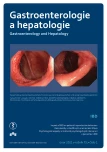(Un)conventional complicated pancreatitis
Authors:
Rybár M. 1; Horný I. 2
Authors‘ workplace:
Gastroenterologická ambulance, Interní oddělení, Nemocnice Český Krumlov, a. s.
1; Gastroenterologické centrum, Interního oddělení, Nemocnice Strakonice, a. s.
2
Published in:
Gastroent Hepatol 2021; 75(1): 61-67
Category:
Clinical and Experimental Gastroenterology: Case Report
doi:
https://doi.org/10.48095/ccgh202161
Overview
Acute pancreatitis is sudden inflammatory disease of pancreas, which can vary from a mild form to severe life threatening condition. The management of pancreatitis usually consists of intensive care and multidisciplinary approach, often including surgical intervention or digestive endoscopy. In this article, we present a 68-year-old female with recidivous acute pancreatitis who underwent a series of endoscopic examinations and at the end also an unusual surgical intervention due to numerous complications. At first, it seemed that there was an idiopatic etiology because neither an anamnesis of alcohol consumption nor metabolic risks or CT signs of cholelithiasis were found. The condition was complicated by the development of acute necrotic collection, gastrointestinal bleeding and development of walled-off pancreatic necrosis (WOPN). Later, the biliary etiology was revealed after cholecystolithiasis was found on abdominal ultrasound. The WOPN was endoscopically drained because of the local compression syndrome. After the drainage, we noticed two cases of stent migration and the secondary infection of the WOPN. At the end, the migrated stents caused transient bowel obstruction and were stuck in the distal ileum. After three unsuccessful attempts to endoscopic extraction, the condition was solved by surgical intervention and double enterotomy was performed. The postoperative care was not easy anyway, being complicated by the dehiscence of the surgical wound with the need of opening the wound and use the VAC system to heal it up.
Keywords:
acute pancreatitis – walled-off pancreatic necrosis – EUS drainage – stent migration – complications – enterotomy
Sources
1. Trna J, Kala Z. Klinická pankreatologie. 1. vyd. Praha: Mladá fronta 2016: 28–91.
2. Kim KO, Kim TN. Acute pancreatic pseudocyst: incidence, risk factors, and clinical outcomes. Pancreas 2012; 41(4): 577–581. doi: 10.1097/ MPA.0b013e3182374def.
3. Stamatakos M, Stefanaki C, Kontzoglou K et al. Walled-off pancreatic necrosis. World J Gastroenterol 2010; 16(14): 1707–1712. doi: 10.3748/ wjg.v16.i14.1707.
4. Ramia JM, de la Plaza R, Quiñones-Sampedro JE et al. Walled-off pancreatic necrosis. Neth J Med 2012; 70(4): 168–171.
5. Baillie J. Pancreatic pseudocysts (Part I). Gastrointest Endosc 2004; 59(7): 873–879. doi: 10.1016/ s0016-5107(04)00354-2.
6. Varadarajulu S, Christein JD, Tamhane A et al. Prospective randomized trial comparing EUS and EGD for transmural drainage of pancreatic pseudocysts (with videos). Gastrointest Endosc 2008; 68(6): 1102–1111. doi: 10.1016/ j.gie.2008.04.028.
7. Kahaleh M, Shami VM, Conaway MR et al. Endoscopic ultrasound drainage of pancreatic pseudocyst: a prospective comparison with conventional endoscopic drainage. Endoscopy 2006; 38(4): 355–359. doi: 10.1055/ s-2006-925249.
8. Gralnek IM, Dumonceau JM, Kuipers EJ et al. Diagnosis and management of nonvariceal upper gastrointestinal hemorrhage: European Society of Gastrointestinal Endoscopy (ESGE) Guideline. Endoscopy 2015; 47(10): a1–a46. doi: 10.1055/ s-0034-1393172.
9. Guo J, Feng L, Sun S et al. Risk factors for infection after endoscopic ultrasonography-guided drainage of specific types of pancreatic and peripancreatic fluid collections (with video). Surg Endosc 2016; 30(7): 3114–3120. doi: 10.1007/ s00464-015-4557-3.
10. Baron TH, Thaggard WG, Morgan DE et al. Endoscopic therapy for organized pancreatic necrosis. Gastroenterology 1996; 111(3): 755–764. doi: 10.1053/ gast.1996.v111.pm8780582.
11. Poc K, Mačinga P, Štirand P et al. Endosonograficky navigovaná drenáž pankreatických kolekcí – vlastní zkušenosti. Gastroent Hepatol 2017; 71(5): 401–408. doi: 10.14735/ amgh2017401.
12. Fasullo M, Al-Azzawi Y, Kheder J et al. Comparing efficacy of lumen-apposing stents to plastic stents in the endoscopic management of mature peripancreatic fluid collections: a single-center experience. Clin Exp Gastroenterol 2018; 11: 249–254. doi: 10.2147/ CEG.S167736.
13. Yang D, Amin S, Gonzale S et al. Clinical outcomes of EUS-guided drainage of debris-containing pancreatic pseudocysts: a large multicenter study. Endosc Int Open 2017; 5(2): E130–E136. doi: 10.1055/ s-0042-121666.
14. Sharaiha RZ, DeFilippis EM, Kedia P et al. Metal versus plastic for pancreatic pseudocyst drainage: clinical outcomes and success. Gastrointest Endosc 2015; 82(5): 822–827. doi: 10.1016/ j.gie.2015.02.035.
15. Ang TL, Kongkam P, Kwek ABE et al. A two-center comparative study of plastic and lumen-apposing large diameter self-expandable metallic stents in endoscopic ultrasound-guided drainage of pancreatic fluid collections. Endosc Ultrasound 2016; 5(5): 320–327. doi: 10.4103/ 2303-9027.191659.
16. Ge N, Hu J, Sun S et al. Endoscopic ultrasound-guided pancreatic pseudocyst drainage with lumen-apposing metal stents or plastic double-pigtail stents: a multifactorial analysis. J Transl Int Med 2017; 5(4): 213–219. doi: 10.1515/ jtim-2017-0036.
17. Siddiqui AA, Kowalski TE, Loren DE et al. Fully covered self-expanding metal stents versus lumen-apposing fully covered self-expanding metal stent versus plastic stents for endoscopic drainage of pancreatic walled-off necrosis: clinical outcomes and success. Gastrointest Endosc 2017; 85(4): 758–765. doi: 10.1016/ j.gie.2016.08.014.
18. Yao Y, Zhang D, Guo J et al. A novel self-expanding biflanged metal stent vs tubular metal stent for EUS-guided transmural drainage of pancreatic pseudocyst: a retrospective, cohort study. Medicine (Baltimore) 2019; 98(3): e14179. Doi: 10.1097/ MD.0000000000014179.
Labels
Paediatric gastroenterology Gastroenterology and hepatology SurgeryArticle was published in
Gastroenterology and Hepatology

2021 Issue 1
Most read in this issue
- A rare cause of the small bowel ulcers
- Psychological aspects and possibilities of psychological intervention in patients with infl ammatory bowel disease
- Proton pump inhibitors – do we know them well and are they really that safe? – part 3
- (Un)conventional complicated pancreatitis
